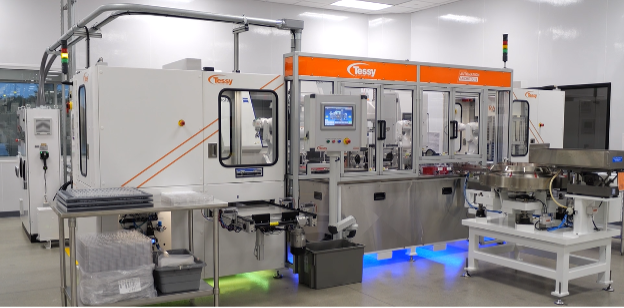AI’s Role in Medical Device Manufacturing & Automation

As medical device manufacturers face increasing pressures to optimize efficiency, reduce waste, and ensure the highest standards of quality, AI has emerged as a crucial ally over the past couple decades. From the micro-scale precision of implantable devices to the robust systems that produce them, AI’s integration into this sector has reached a state that is not just improving processes, but also redefining possibilities. Through the lens of medical device manufacturing, we see a future where AI does not replace human expertise but empowers it, ensuring that every component manufactured not only meets but exceeds the expectations of a rapidly evolving healthcare landscape.
Why The Buzz Around AI?
What sets AI apart from static algorithms and programs are its machine learning (ML) capabilities. In its most basic form, ML refers to an AI’s ability to adapt its execution path and resulting performance based on data analysis of its own previous work. In essence, ML is what enables AI to “learn by doing”. This ML capability is what makes AI especially exciting for those in the medical manufacturing industry, where continuous improvement is a pillar of operations and a way of being.
Using AI for Continuous Improvement in Medical Manufacturing
As a result of this defining feature, AI can be used to audit and optimize manufacturing processes across the board. AI can often identify opportunities for improvement that may be otherwise overlooked in a process audit performed by a human. While some of those individual optimization opportunities may seem inconsequential on their own, the benefits can compound upon one another for significant efficiency improvement overall.
At Tessy, continuous improvement initiatives help us exceed customer expectations with high quality medical devices and low manufacturing costs. Contact us today for a medical device manufacturing consultation.
Using AI for Medical Device DFM
In similar fashion, AI has demonstrated its prowess as an effective tool for DFM analysis across all industries, and the medical device manufacturing sector is no exception to that. For example, imagine that an injection molding manufacturer has a CAD model for a medical device or component. It’s now common practice to run the CAD file through a manufacturing simulation software to get an idea of what to anticipate when producing the part on a real manufacturing line. Where AI can help is in quickly identifying features of the tooling design, or design of the part itself, that can be further improved to increase cavitation, all before the first iteration of the tooling is ever created. With enough time, the people behind the part or tooling design would be able to identify these chances for DFM improvement, but a properly trained AI program can bring those same design features to their attention in just seconds.
AI in Medical Device Material Selection
In medical device manufacturing, selecting the right material is crucial not only for functionality and cost-efficiency but also to ensure safety and adherence to customer specifications. AI can dramatically streamline this decision-making process. By inputting desired properties such as tensile strength, flexibility, biocompatibility, and cost parameters, AI systems can analyze vast databases of material properties to suggest optimal materials. For example, an AI could recommend a specific polymer that meets the rigid material requirements for surgical tools while also being cost-effective. Additionally, AI can predict how materials will react under real-world conditions, aiding in the development of more durable and safer medical devices.
We do more than understand the importance of precision manufacturing- we prioritize it to give our medical device customers peace of mind. Click below to discover the full extent of our dedication to serving the medical industry.
How AI Boosts Quality Control and Quality Analysis
AI’s role in quality control and analysis can significantly enhance both the efficiency and the effectiveness of medical device manufacturing lines. At various production stages, AI can employ contactless imaging techniques like x-ray, infrared, ultrasound, or even microscopic imaging for non-invasive inspections to detect abnormalities and defects. ML algorithms can learn from a dataset of defect-free products and continuously refine their understanding as they are exposed to new anomalies, leading to increasingly accurate identification of defects.
While automated rejection can do wonders for increasing product quality, even more impressive is how manufacturing processes can adapt to maintain quality using AI assistance. AI can help in statistical process control by analyzing the data collected during manufacturing to ensure that the process remains within set quality standards. It can automatically adjust processes in real-time to maintain quality standards, significantly reducing the variability that human operators might overlook.
Advancing Preventative Maintenance with AI
AI can also integrate with other technologies such as IoT sensors to monitor the medical manufacturing environment continuously. By analyzing data from these sensors in real time, AI can predict machine failures before they occur, or detect subtle deviations in the manufacturing process that might affect product quality. In doing so, these programs can preemptively address issues that could lead to product recalls or safety concerns. Whether concerning cash flow or brand reputation, the potential cost savings of AI-enhanced preventative maintenance are near immeasurable.
Key Takeaways
At the end of the day, it cannot be overstated that AI suggestions are just that- suggestions. Like any computer program, an AI can only be as smart as it’s trained to be, even with advanced ML capabilities. While AI technology certainly won’t be replacing the human element of medical device manufacturing operations, it can be an invaluable tool in analyzing data in a way that expedites and informs decision making processes.
